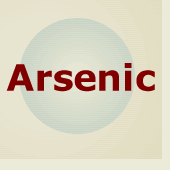Arsenic
On this Page

NIOSH Resources
NIOSH Pocket Guide to Chemical Hazards
Exposure limits, Respirator Recommendations, First Aid, more...
The Pocket Guide is a source of general industrial hygiene information on several hundred chemicals/classes found in the work environment. Key data provided for each chemical/substance includes name (including synonyms/trade names), structure/formula, CAS/RTECS numbers, DOT ID, conversion factors, exposure limits, IDLH, chemical and physical properties, measurement methods, personal protection, respirator recommendations, symptoms, and first aid.
International Chemical Safety Cards
An ICSC summarizes essential health and safety information on chemicals for their use at the "shop floor" level by workers and employers in factories, agriculture, construction and other work places.
Documentation for Immediately Dangerous to Life or Health Concentrations (IDLH)
The IDLH documents the criteria and information sources that have been used by NIOSH to determine immediately dangerous to life or health concentrations.
The Emergency Response Safety and Health Database (ERSH-DB)
Developed by NIOSH for the emergency response community, The ERSH-DB contains accurate and concise information on high-priority chemical, biological and radiological agents that could be encountered by personnel responding to a terrorist event.
NIOSH Alert – Reducing the Potential Risk of Developing Cancer from Exposure to Gallium Arsenide in the Microelectronics Industry
DHHS (NIOSH) Publication No. 88-100 (October 1987)
Recent experimental animal studies have indicated that gallium arsenide dissociates in the body to release gallium and arsenic. The arsenic is inorganic, biologically available, and distributed throughout the body.
Current Intelligence Bulletin No. 14 – Inorganic Arsenic (respiratory)
DHHS (NIOSH) Publication No. 78-127 (September 1976)
Contains a standard for mitigation of exposure to inorganic arsenic (respiratory) to prevent adverse effects over a working lifetime.
NIOSH Criteria Document – Criteria for a Recommended Standard: Occupational Exposure to Inorganic Arsenic
DHHS (NIOSH) Publication No. 75-149 (1975)
Presents a standard to prevent the adverse effects of exposure to arsenic over a working lifetime.
NIOSH Manual of Analytical Methods (NMAM)
NMAM is a collection of methods for sampling and analysis of contaminants in workplace air, and in the blood and urine of workers who are occupationally exposed.
- Arsenic by AA (No. 7900) [PDF - 18.5 KB]
Occupational Safety and Health Guideline for Arsenic [PDF - 308 KB]
Related Resources
Agency for Toxic Substances Disease Registry (ATSDR) - TOXFAQS: Arsenic
Toxicological Profile for Arsenic (ATSDR)
OSHA (Safety and Health Topics): Arsenic
OSHA (Chemical Sampling information): Arsenic
New Jersey Hazardous Substance Fact Sheets: Arsenic [PDF - 605.42 KB]
Risk Assessment Information System (RAIS): Arsenic
EPA (Air Toxics): Arsenic Compounds
EPA - Arsenic in Drinking Water
Integrated Risk Information System (IRIS): Arsenic
NLM (Hazardous Substance Data Bank): Arsenic
NTP-Report on Carcinogens, Twelfth Edition (2011): Arsenic [PDF - 108.7 KB]
IARC Monographs (Vol. 2): Arsenic [PDF - 29.05]
IARC Monographs (Supplement 7): Arsenic [PDF - 28 KB]
European Chemical Substance Information System (ESIS): Arsenic
- Page last reviewed: February 4, 2014
- Page last updated: February 4, 2014
- Content source:
- National Institute for Occupational Safety and Health Education and Information Division


 ShareCompartir
ShareCompartir